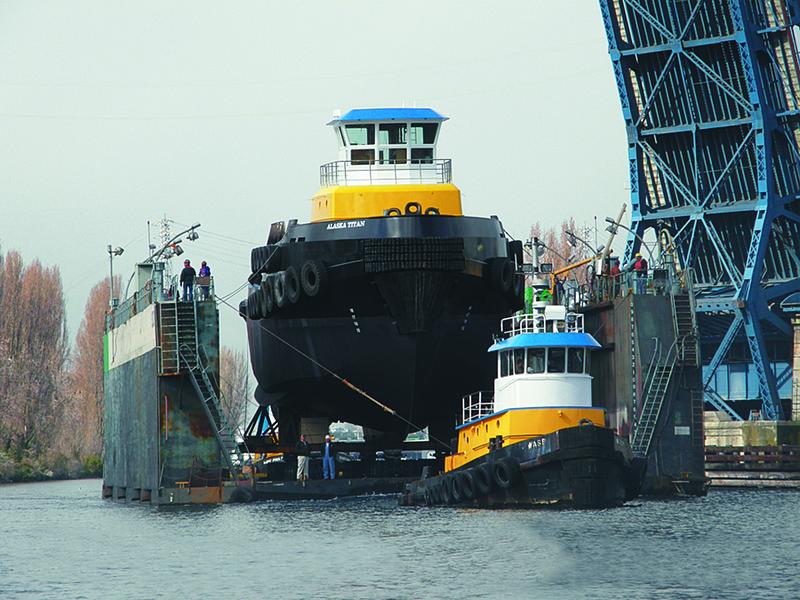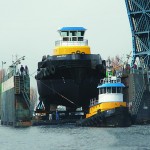- 9/1/2008
Old.”
That’s how naval architect Frank Basile of Entech & Associates , Houma, La., characterizes the U.S. oceangoing tug fleet.
As of January, the U.S. had 1,440 “seagoing tugs” over 100 GRT with an average age of almost 38 years, according to Lloyd’s Register . The stats don’t include the age of the engines, but it’s a safe assumption that many of them are “old” too.
And these days, old engines means dirty and inefficient engines.
Basile said that a client of his recently reported a fuel burn of 5,100 gpd for towing a barge with his new tug. The larger boat it replaced had burned over 10,000 gpd and was only half a knot faster. He said he saved over 20,000 gals. during the trip.
“People are searching for more efficient boats,” said Basile, “boats that burn less fuel and go faster.”
Earlier this year, Smith Marine Towing , Amelia, La., took delivery of a new oceangoing tug, the Smith Predator , designed by Entech. The 88′ x 32′ x 12′ model-bow tug is powered by twin 1,500-hp Caterpillar 3512s. The new tug and its sister, the Smith Invader , were built at Mariner Shipyard in Houma.
Thomas Tamplain, operations and maintenance manager at Smith Marine, said that while fuel costs are paid for by the customer, he believes that having new, fuel-efficient engines is a competitive advantage. “Actually, it’s been a topic more than once over the past year or so where compared to the EMD-powered boats, which are not very fuel efficient at all, the Cat boats, when you tell them the horsepower and your fuel burn, it’s a selling point, no doubt.”
NEW FOSS TUGS
Foss Maritime Corp. has been assessing its fleet of oceangoing tugs and decided that it’s time to replace them.
“We have a design that we’ve been working on with Glosten [Associates] for about two years,” said Gary Faber, president and COO of the Seattle-based company. He calls it a “bottom-up” design that will be the basis for “a new generation, long-haul towboat that has some very unique characteristics and will have a little different look than the traditional, model-hull boats you see coming out of the yards. We’ll finish up the Dolphin-class harbor tugs this year [at Foss’ Rainier, Ore., shipyard] and get into the construction of the new towboats next year.”
Faber wouldn’t go into detail about the new design but said, “it will be flexible enough that I can take it to different horsepowers and to different fuel capacities by standardized modules. If you think in terms of a stern module, a midship module and a bow module, you can put in different modules for the midship section and it gives you either a bigger or smaller boat with more or less power and more or less fuel [capacity]. So you’re flexible and you can meet whatever that demand is going to be, but it’s with standardized construction so you don’t need to reinvent the wheel every time you get a different application.”
The new long-haul tugs will be one of three standardized tug classes at Foss. “We’re going to build three classes of boats. We’ll have standardized spares, and we’ll have the same boat throughout the fleet. We’re going to build a boat a year until we replace and rebuild our fleet and until it’s the biggest and most modern fleet in the states for tug-and-barge operations.”
Faber said he sees this newbuild program as “a paradigm shift in what we’re doing.”
This may mean suffering some pioneering hardships, but “we’ve decided that we’re going to jump out there – just like with the hybrid tug – with this new generation of boats, and I’m confident that its going to be successful and in the long run it’s going to be good for the company,” he said.
Faber added that many of its towboats are 25 to 35 years old and it’s time to go with new technology. “Sometimes you get stuck in this longer-is-better [philosophy], but I think it’s time for another generation of outside towboats that don’t leave as much of a footprint. You get some operating efficiencies out of that, but more importantly, the crews get a better platform. It’s quieter, it’s more comfortable, it’s safer, it’s a better quality of life.
“One of the things really facing our industry right now is that we need to be more environmentally sensitive, and we need to give the crews a better quality of life if we’re going to compete for manpower,” continued Faber. “How do we compete? We get a better product for the worker to be on … we get to where they want to be here. You’ve got to have better equipment for that. They aren’t going to go around getting their brains beat out in a 30-year-old boat.”
NEW BOATS FOR WESTERN
Western Towboat Co., a Seattle-based competitor of Foss, operates a substantially newer fleet of oceangoing tugs and business has been growing.
To handle the increase in business, Western Towboat will add three more 120′, 5,000-hp, Titan-class oceangoing tugs to its fleet, which now stands at 21. Western builds its own boats, and it just completed the 120′ x 35′ x 20′ Alaska Titan . The new tug is powered by Caterpillar 3516 long-stroke engines that produce 2,500 hp each.
Western’s oceangoing tugs also have the distinction of being Z-drives.
Ric Shrewsbury, one of the company owners, said Z-drives are very useful for docking barges in Alaska, and he likes their adaptability and efficiency. “They’re so much more versatile for their size,” he said. “Our Z-drive boats get a lot better flow to the wheels because the wheels are at a closer angle to the flow of the water coming up the stern of the boat.”
Shrewsbury and his brother, Bob, are second-generation tugboaters and have seen a lot of changes over the years, particularly in fuel prices.
“The fuel costs now are more than the daily rate for the vessel,” he said, also noting that their barge customers pay for all the fuel. Even so, having new, fuel-efficient equipment is an advantage. “Our fuel consumption is probably 10 to 20 percent less than some of our competitors. When you’re competing against a 7,000-horsepower tug with a 5,000-horsepower tug and virtually doing the same thing, unless they are willing to run fairly slow, the fuel and lube oil consumption on our side is a big plus.”


Original article: http://www.workboat.com/component/content/article?id=8447

